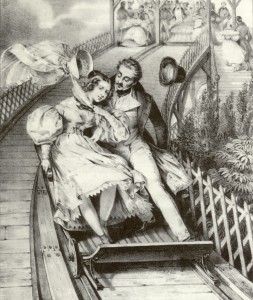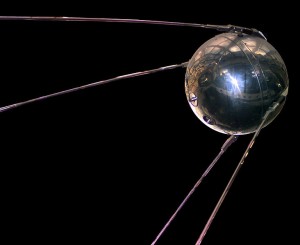More than I expected, really. (Thanks Reddit.)
You are currently browsing the yearly archive for 2011.

"Some colonies had laws against feeding lobsters to inmates more than once a week because it was thought to be cruel and unusual, like making people eat rats." (Image by Steve Rhodes.)
The late David Foster Wallace has previously unpublished fiction in the New Yorker this week, but here’s an interesting fact from his landmark 2004 food writing, “Consider the Lobster“:
“Up until sometime in the 1800s, though, lobster was literally low-class food, eaten only by the poor and institutionalized. Even in the harsh penal environment of early America, some colonies had laws against feeding lobsters to inmates more than once a week because it was thought to be cruel and unusual, like making people eat rats. One reason for their low status was how plentiful lobsters were in old New England. ‘Unbelievable abundance’ is how one source describes the situation, including accounts of Plymouth pilgrims wading out and capturing all they wanted by hand, and of early Boston’s seashore being littered with lobsters after hard storms—these latter were treated as a smelly nuisance and ground up for fertilizer. There is also the fact that premodern lobster was often cooked dead and then preserved, usually packed in salt or crude hermetic containers. Maine’s earliest lobster industry was based around a dozen such seaside canneries in the 1840s, from which lobster was shipped as far away as California, in demand only because it was cheap and high in protein, basically chewable fuel.”
Tags: David Fpster Wallace
I would punt this creepy thing clear across the mall, but I wonder if some people would like the “attention.” Regardless: yikes! (Thanks Singularity Hub.)

"A mathematician, a former peacenik, and an enemy of exclusive government control of encryption systems."
Whitfield Diffie created a tool to help him explain a product, but it was the tool itself that was the great product. To understand how Diffie never made a cent from his creation of the game-changing invention of PowerPoint, read this 2001 article by the excellent New Yorker writer Ian Parker. An excerpt:
“In 1980, though, it was clear that a future of widespread personal computers—and laser printers and screens that showed the very thing you were about to print—was tantalizingly close. In the Mountain View, California, laboratory of Bell-Northern Research, computer-research scientists had set up a great mainframe computer, a graphics workstation, a phototypesetter, and the earliest Canon laser printer, which was the size of a bathtub and took six men to carry into the building—together, a cumbersome approximation of what would later fit on a coffee table and cost a thousand dollars. With much trial and error, and jogging from one room to another, you could use this collection of machines as a kind of word processor.
Whitfield Diffie had access to this equipment. A mathematician, a former peacenik, and an enemy of exclusive government control of encryption systems, Diffie had secured a place for himself in computing legend in 1976, when he and a colleague, Martin Hellman, announced the discovery of a new method of protecting secrets electronically—public-key cryptography. At Bell-Northern, Diffie was researching the security of telephone systems. In 1981, preparing to give a presentation with 35-mm. slides, he wrote a little program, tinkering with some graphics software designed by a B.N.R. colleague, that allowed you to draw a black frame on a piece of paper. Diffie expanded it so that the page could show a number of frames, and text inside each frame, with space for commentary around them. In other words, he produced a storyboard—a slide show on paper—that could be sent to the designers who made up the slides, and that would also serve as a script for his lecture. (At this stage, he wasn’t photocopying what he had produced to make overhead transparencies, although scientists in other facilities were doing that.) With a few days’ effort, Diffie had pointed the way to PowerPoint.” (Thanks Longform.)
••••••••••
More about Whitfield Diffie from Steven Levy: “Mary Fischer loathed Whitfield Diffie on sight. He was a type she knew all too well, an MIT brainiac whose arrogance was a smoke screen for a massive personality disorder. The year of the meeting was 1969; the location a hardware store near Central Square in Cambridge, Massachusetts. Over his shoulder he carried a length of wire apparently destined for service as caging material for some sort of pet. This was a typical purchase for Diffie, whose exotic animal collection included a nine-foot python, a skunk, and a rare genetta genetta, a furry mongooselike creature whose gland secretions commonly evoked severe allergic reactions in people. It lived on a diet of live rats and at unpredictable moments would nip startled human admirers with needlelike fangs.”
Tags: Ian Parker, Mary Fischer, Steven Levy, Whitfield Diffie
From the New York Times obituary of Bacon, one of the most divisive artists ever: “Mr. Bacon first gained acclaim in 1945, when he exhibited ‘Three Studies for Figures at the Base of the Crucifixion‘ at the Lefevre Gallery in London. His angrily drawn image of writhing half-human, half-animal forms, perched atop pedestals and set in claustrophobic spaces, seemed to epitomize the grim spirit of postwar England and established the painter immediately as a master of the macabre. That reputation was to be reinforced time and again by the screaming popes, butchered carcasses and distorted portraits that Mr. Bacon turned out over the next four and a half decades.” (Thanks Live Leak.)
Tags: Francis Bacon
Please help me with “nothing”! – $1 (Brooklyn)
Please help me with nothing!
i dont need anything from you!
i need only an IDEA!
I am looking for a good business idea from where i can make a little income so if you think from “anythink” what you think that i can earn money, please do a favor & email me back with the idea
if you know from any item or service what is a big demend & nobody offer this, that can be for me a great thing to start.
UPDATE: Popular Science made a couple of crucial errors in its original story about Dr. Atala’s bio-printer presentation at TED. Thanks to Karen Richardson, who does publicity for Wake Forest, for sending me the corrections:
“Reports in the media that Dr. Anthony Atala printed a real kidney at the TED conference in Long Beach, Calif., are completely inaccurate. At the conference, Dr. Atala used a new type of technology to print a kidney-shaped mold and explained how one day – many years from now – the technology might be used to print actual organs.
At the conference, Atala was reunited with a former patient who received a laboratory-engineered bladder 10 years ago. News reports are incorrectly saying that he received a printed kidney.”
••••••••••
Bio-printing replacement organs and tissue is coming sooner than later, and that’s a great thing, since kidneys in particular are in great demand and short supply. Yesterday surgeon Anthony Atala of Wake Forest took the TED stage at Long Beach and “printed” a working human kidney. It’s a stunner, but the process has been in the testing phase for a decade. An excerpt from an Independent story:
“College student Luke Massella was among the first people to receive a printed kidney during experimental research a decade ago when he was just 10 years old.
He said he was born with Spina Bifida and his kidneys were not working.
‘Now, I’m in college and basically trying to live life like a normal kid,’ said Massella, who was reunited with Atala at TED.
‘This surgery saved my life and made me who I am today.'”
••••••••••
No footage yet of Dr. Atala’s demonstration from yesterday, but here he is discussing the topic at TED in 2010.
Tags: Anthony Atala, Luke Massella
Not a single woman, sadly, but James Baldwin, Marlon Brando, Harry Belafonte, Charlton Heston, Joseph L. Mankiewicz and Sidney Poitier!!! (Thanks Open Culture.)
Tags: Charlton Heston, Harry Belafonte, james Baldwin, Joseph L. Mankiewicz and Sidney Poitier, Marlon Brando

"Ezra F. Merrill, the wealthy owner of toboggan slides at Coney Island and roller coaster devices." (Image by Buchhändler.)
Ezra F. Merrill was one of the key forces behind the introduction of the toboggan slide to Coney Island, and he also built some popular roller coasters. But his rides weren’t always fun and safe and resulted in numerous injuries and deaths, with scalps lost and skulls crushed. As reported in the May 10, 1899 Brooklyn Daily Eagle, the scream machines even eventually claimed the aged proprietor himself, who was something of an eccentric figure. An excerpt:
“The death of Ezra F. Merrill, the wealthy owner of toboggan slides at Coney Island and roller coaster devices, will be the subject of an investigation by Coroner Burger. Dr. Byrne, the Register of Vital Statistics of the local Health Office, declined to accept the death certificate of the attending physician on the ground that death was due to traumatic or violent origin.
Merrill, who was a character, attended to all his business interests personally. It is said that he was a millionaire, but he dressed like a laborer and ate at the cheapest restaurants on the island. He was trying a new roller coaster car one day last week when it slipped from its moorings and struck him in the stomach. The result was that peritonitis developed and that was given as the cause of death.”
Tags: Coroner Burger, Dr. Byrne, Ezra F. Merrill
Kevin Kelly defines “technology” on his blog:
“I want to suggest a theory for technology, a framework that might provide a logic and context for this parade of new things in our lives. But I have to start with the fact that we have a warped idea of what technology is. A lot of us tend to think that technology is ‘anything that was invented after you were born.’ Or technology is: ‘anything that doesn’t work yet.’ As if only the new is what we are talking about.
But of course technology includes old inventions, like clocks and levers, and ancient materials that work very well, like concrete and bricks. The bulk of technology in our lives was invented long before we were born. Ordinary technology also contains intangible ‘stuff’ that we usually don’t see such as calendars, bookkeeping principles, law, and software. It includes large complex things like social organizations and cities. Technology is all this, the old, the invisible, the large and the new — the accumulated usefulness that our minds invent.”
Tags: Kevin Kelly
From the 1940s until the mid-1970s, a blind Manhattan street musician nicknamed “Moondog” used to stand on Sixth Avenue and 53rd Street, dressed like a Viking. At a time when outré characters were all over the city, he just seemed like one more eccentric. But Moondog (real name: Louis Thomas Hardin) also happened to be an acclaimed classical composer. Filmmaker Holly Elson is hoping to make a documentary about the late musician, who passed away in 1999, and this is the very earliest piece of it. (Thanks Documentarian.)
Tags: Holly Elson, Louis Thomas Hardin, Moondog

""Despite his name and appearance, Hate isn't what you might expect from a homeless person." (Image by TwoWings.)
Even by Berkeley’s very relaxed standards of behavior, homeless philosopher Mark Hawthorne stands out. Known locally as “Hate Man,” he believes in sharing negative feelings towards others, even while otherwise treating them kindly. He always has a “fuck you” at the ready for anyone who crosses his path, but he had a much larger vocabulary when he was a reporter for the New York Times from 1961 to 1970. How he get from his old life to his current one is the subject of a story by Kathleen Richards and Sandeep Abraham in the East Bay Express. An excerpt:
“Despite his name and appearance, Hate isn’t what you might expect from a homeless person — especially one that greets others with ‘fuck you’ and eats out of garbage cans. He is kind, and his gentle eyes belie the hardened life of decades spent on the streets. He is also thoughtful and clearly educated — not to mention quite a talker.
Some of his followers say they help keep the peace in People’s Park. Hate says he doesn’t like to take handouts from anyone, doesn’t drink, and no longer does drugs. His only vices appear to be Virginia Slims cigarettes, the smoke of which engulfs him in a perpetual halo, and coffee, which he carries in a glass jar and loads up with sugar.
How he went from reporting for The New York Times to leading homeless people in Berkeley as a pseudo prophet involves a long, strange trip and a string of failed relationships. It may sound like a fall from grace, but Hate says he’s exactly where he’s always wanted to be.” (Thanks Longreads.)
Tags: Hate Man, Kathleen Richards, Mark Hawthorne, Sandeep Abraham
Your student moving help for my beer (Brooklyn or NYU)
Hi all – I’m a female NYU student who needs two male students to move some heavy movie equipment for my student film. I have no cash, but through a weird cool connection I can hook you up with beer. A suitcase each man for the move. Same day beer pay.
Demand has not yet matched supply. (Thanks IEEE Spectrum.)

Kirkpatrick's article details Jack Dorsey's new company, Square, which has created a way for individuals to accept credit card payments with the aid of a cell phone attachment. (Image by Joi Ito.)
An explanation for how Twitter was created, from David Kirkpatrick’s smart Vanity Fair article about Jack Dorsey, the company’s founder and deposed CEO:
“Little Jack Dorsey was obsessed with maps of cities. He papered his walls with maps from magazines, transit maps, maps from gas stations. His parents had resisted joining the emigration to the suburbs, and their shy, skinny son supported them by becoming a passionate proponent of city life. He was mesmerized by locomotives, police cars, and taxis. He would drag his younger brother Danny to nearby rail yards, where they waited just to videotape a passing train.
When their father brought home the family’s first computer that year—an IBM PC Jr.—Jack immediately took to it. He had a talent for both math and art, and began to design his own maps using a graphics program. Soon, he taught himself programming to learn how to make little dots—representing trains and buses—scoot around the maps. He spent hours listening to police and ambulance radio frequencies, then plotted the emergency vehicles as they moved toward an accident or a hospital. As he evolved into a talented teenage programmer, he came to an oddly poetic view of this precise, orderly urban grid. ‘I wanted to play with how the city worked, so I could see it,’ Dorsey recalls.
His obsession with cities—and with programming—never abated. By early 2006, having dropped out of N.Y.U. and bouncing between jobs, he found himself working for a San Francisco software start-up called Odeo, which was going nowhere. One day he proposed an idea to his boss based on a notion that Dorsey had been noodling over for years. He was fascinated by the haiku of taxicab communication—the way drivers and dispatchers succinctly convey locations by radio. Dorsey suggested that his company create a service that would allow anyone to write a line or two about himself, using a cell phone’s keypad, and then send that message to anyone who wanted to receive it. The short text alert, for him, was a way to add a missing human element to the digital picture of a pulsing, populated city.”
••••••••••
Jack Dorsey’s first computer, the IBM PC Jr.
Tags: David Kirkpatrick, Jack Dorsey
The “Bubble Tree” costs about $12K and is designed by Pierre-Stéphane Dumas. (Thanks ShelterPop.)
Tags: Pierre-Stéphane Dumas
This classic photograph of Mulberry Street from 1900 (photographer unknown) provides a glimpse of life among the neighborhood’s pushcart peddlers. A few brief stories from the Brooklyn Daily Eagle about Mulberry Street from that era further explain lives of the area’s residents.
••••••••••
“Monkeys in Court” (June 25, 1889): “Francis Samboni and Angelo Antonio, of 150 Mulberry street, New York, and their respective monkeys, Jacko and Jackino, were arrested this morning and taken before Justice Goetting on a charge of not being licensed. The monkeys, imitating their masters, deferentially doffed their plumed caps in the presence of the justice and chattered something which they only understood themselves. The justice fined the men $1 each.”
••••••••••
“Poured Hot Syrup on Him” (August 2, 1890): “Two Italians–John Loui of 940 Mulberry street, New York, and Rocco Passo, of 55 Baxter street, New York, had a fight at 10:30 o’clock this morning in front of 971 Mulberry street, when Loui seized a large dipper full of hot syrup and struck Passo on the head with it. Passo was badly burned and was attended to by Dr. Shea of St. Vincent’s hospital. Loui was locked up in the Prince street police station.”
••••••••••
“The Fruit Vendor Murder” (July 24, 1894): “Francesco Antonio Colluchio, 25, years old, of 116 Mulberry street, the murderer of Giuseppe Tamasco, a fruit vendor of 114 Mulberry street, New York, was taken before Justice Ryan in the Tombs police court this morning and held without bail. Colluchio quarreled with Tamasco in front of 114 Mulberry street at 6 o’clock last night over two bananas which Colluchio had bought from a vendor for 1 cent.
There was a difference in the quality of the fruit and Tamasco refused to exchange it or refund the money. The two men began to struggle on the walk. In the fight Colluchio drew a stiletto and stabbed the vendor in the heart killing him instantly.”
••••••••••
“The Music Knocked Him Out” (March 23, 1888): “Michaelo Petrie, an Italian organ grinder of 115 Mulberry street, New York, was overcome by emotion while reeling off ‘Stick to Your Mother, Tom,’ in front of H.C. Atwood’s dry goods store at 1,197 Broadway, this city, last night, and fell through a plate glass window. He was cut in several places but was able to go home.”
••••••••••
“Suspicious Character” (February 7, 1885): “Michael McNulty, of Mulberry street, New York, was before Justice Massey this morning, charged with being a suspicious character.”

"That it could spin half-discernible essays on postmodern theory before it could be shown a chair and say, as most toddlers can, 'chair'?"
From “Mind vs. Machine,” an article in the Atlantic by Brian Christian.
“As for the prospects of AI, some people imagine the future of computing as a kind of heaven. Rallying behind an idea called ‘The Singularity,’ people like Ray Kurzweil (in The Singularity Is Near) and his cohort of believers envision a moment when we make smarter- than-us machines, which make machines smarter than themselves, and so on, and the whole thing accelerates exponentially toward a massive ultra-intelligence that we can barely fathom. Such a time will become, in their view, a kind of a techno-Rapture, in which humans can upload their consciousness onto the Internet and get assumed—if not bodily, than at least mentally—into an eternal, imperishable afterlife in the world of electricity.
Others imagine the future of computing as a kind of hell. Machines black out the sun, level our cities, seal us in hyperbaric chambers, and siphon our body heat forever.
I’m no futurist, but I suppose if anything, I prefer to think of the long-term future of AI as a kind of purgatory: a place where the flawed but good-hearted go to be purified—and tested—and come out better on the other side.
Who would have imagined that the computer’s earliest achievements would be in the domain of logical analysis, a capacity once held to be what made us most different from everything else on the planet? That it could fly a plane and guide a missile before it could ride a bike? That it could create plausible preludes in the style of Bach before it could make plausible small talk? That it could translate before it could paraphrase? That it could spin half-discernible essays on postmodern theory before it could be shown a chair and say, as most toddlers can, ‘chair’?
As computers have mastered rarefied domains once thought to be uniquely human, they simultaneously have failed to master the ground-floor basics of the human experience—spatial orientation, object recognition, natural language, adaptive goal-setting—and in so doing, have shown us how impressive, computationally and otherwise, such minute-to-minute fundamentals truly are.
We forget how impressive we are. Computers are reminding us.”
Tags: Brian Christian
Big enough to break your ass but good. (Thanks Crunchy.TV.)
From the Science section of the New York Times:
“Q. You know the five-second rule for dropped food? Is it really safe if you pick it up in time?
A. “The five-second rule probably should become the zero-second rule,” said Dr. Roy M. Gulick, chief of the division of infectious diseases at Weill Cornell Medical College. “Eating dropped food poses a risk for ingestion of bacteria and subsequent gastrointestinal disease, and the time the food sits on the floor does not change the risk.”
In general, if there are bacteria on the floor, they will cling to the food nearly immediately on contact, Dr. Gulick said. Factors that influence the risk and the rate of bacterial transfer include the type of floor; the type of food; the type of bacteria; and how long the bacteria have been on the floor.”
Tags: Dr. Roy M. Gulick
sexual oddities – $25 (philadelphia, pa)
SEXUAL FREAKS OF NATURE
Did I get your attention? Long ago a wise man once said, “Seeing is believing.” I am now going to put that to the proof. I am offering a series of video tapes for any standard VHS. In the early 1970’s, some genius rounded up a series of sex freaks and taped them doing their thing. These tapes can’t be had for love or money, after all, we are now living in a DVD world. A lot of things recorded long ago on a vanished medium are going the way of the saber-toothed tiger. BUT, some of us far-sighted individuals kept their precious recordings, and now I am in a position to hand down my hoarded collection.
What am I offering. Simply, video tapes of extremely gifted individuals.
1) Freaks of Nature No. 4 a) The Blob. A middle aged guy, slightly overweight, with a penis approx. 1 foot long and as thick around the base as a grapefruit, being worked on by a buxom female.
b) Ron Jeremy with a big-breasted babe, who then milks herself.
c) Hard core hermaphrodite scene
d) Double-dicked gent who eventually cums from both members.
e) Two very lucky guys, one with a dick head the size of a mushroom, and the other with a 3 foot long penis.
f) An oriental guy with a 3 foot dick gets oral sex, then balls himself
g) Another scene with The Blob
h) A babe with enormous breasts services two herms, one with a dick 2 feet long.
i)Another scene with a guy with two dicks
j) Rom Jeremy and a chick with wonderful vaginal muscle control
k) Another scene with mushroom head and a 3 foot long dicked guy
2) Best of Dixie Dynamite and Long Dan Silver. WOW, talk about a combo! Dixie Dynamite is some chick with breasts like water melons, damned if I can figure out how she sleeps. She had a brief appearance on the Howard Stern Show once upon a time. He couldn’t keep his eyes off of her. Long Dan Silver has to be one of the luckiest guys born (other than Bill Gates). Honestly, I don’t know why he doesn’t faint when he gets a hard-on. It’s so big he can’t fit it into a very willing chick’s pussy. CHECK THIS OUT!
3) Freaks of Nature No. 6 a) A 102 y/o man has sex with a young blond.
b) Girl with 3 inch nipples having fun with another girl’s pussy
c) Guy with two dicks
d) Sex with chubby chicks
e) Guy with super long tongue – at least a foot long – having fun with chick’s pussy
f) Nice lactating tits
g) Guy with 3 foot dick takes it up his butt
h) Return of The Blob
i) Two hermaphrodites, one with a 2 foot long dick
k) Double penetration he – shes
l) Double dicked gent, again
4) King Kong Dongs – Series of scenes of eye-poppingly giant cocks being serviced by a bevy of slurp-tongued beauties.
5) Six Girls and Long Dan Silver – A lucky, lucky, lucky, lucky, lucky, lucky guy with a cock half again as big as a Louisville Slugger.
6) Robo Cock – Our friend again: Long Dan Silver
7) King Kong Dongs No. 2 – More scenes of disgustingly endowed men and their vixens.
8) Double Penetration He Shes – Two scenes of hermaphrodites having fun with each other and a third person. The blond’s dick is easily 2 feet long, and she flexes it to prove it’s real.
9) Freaks of Nature No. 5 – more scenes featuring John Holmes, super long tongue, a girl born with two dicks, Wendy Whoppers, The Blob, and more guys with three foot dicks.
10) Extreme Sex – no sex freaks, just a porn flick I,ve enjoyed more than most.
“Lift” is an excellent 24-minute documentary from 2001 by director Mark Isaacs, in which he camps out in the lift of a residential tower in the East End of London and films the tenants as they travel vertically. Wary at first, the residents soon relax and human nature (in all its forms) emerges.
From Stewart Brand’s “Spacewar: Fanatic Life and Symbolic Death Among the Computer Bums,” published in Rolling Stone in 1972:
“After Russia’s Sputnik humiliated the US in the middle of the Fifties, America came back hard with the Mercury Program, John Glenn and all that, crash-funded through a new agency directly under the Secretary of Defense – ARPA (Advanced Research Projects Agency).
When the US space program was moved out of the military to become NASA, ARPA was left with a lot of funding momentum and not much program. Into this vacuum stepped J.C.R. Licklider among others, with the suggestion that since the Defense Department was the world’s largest user of computers, it would do well to support information-medium like computers.
So in 1963 a fraction of ARPA’s budget, some $5-8 million, went into a program called IPT, Information Processing Techniques, under the initial direction of Licklider and then of a 26-year-old named Ivan Sutherland. Sutherland, the developer of ‘Sketchpad’ at MIT, gave the agency its bias toward interactive graphics and its commitment to ‘blue sky mode’ re- search. The next director, Bob Taylor, then 32, doubled I PT’s . budget (while ARPA’s overall budget was shrinking) and administered a five-year golden age in computer research.
The beauty was, that being at the very top of the Defense Establishment, the agency had little Congressional scrutiny had little bureaucratic responsibility, able to take creative chances and protect long-term deep-goal projects. Alan Kay: ’90 percent of all good things that I can think of that have been done in computer science have been done funded by that agency. Chances that they would have been funded elsewhere are very low. The basic ARPA idea is that you find good people and you give them a lot of money and then you step back. If they don’t do good things in three years they get dropped – where ‘good’ is very much related to new or interesting.’
One of the accomplishments of ARPA-funded research during this time was time-sharing, Time-sharing is a routing technique that allows a large number of users to sit down ‘on-line’ with a. computer as if each were all alone with it. Naturally, timesharing was of no interest to computer manufacturers like IBM since it meant drastically morc efficient use of their hardware.”
••••••••••
Spotnik’s launch, October 4, 1957:
From Goodreads.com: “Anti-intellectualism has been a constant thread winding its way through our political and cultural life, nurtured by the false notion that democracy means that ‘my ignorance is just as good as your knowledge.’“
Tags: Isaac Asimov
Sword wins.









